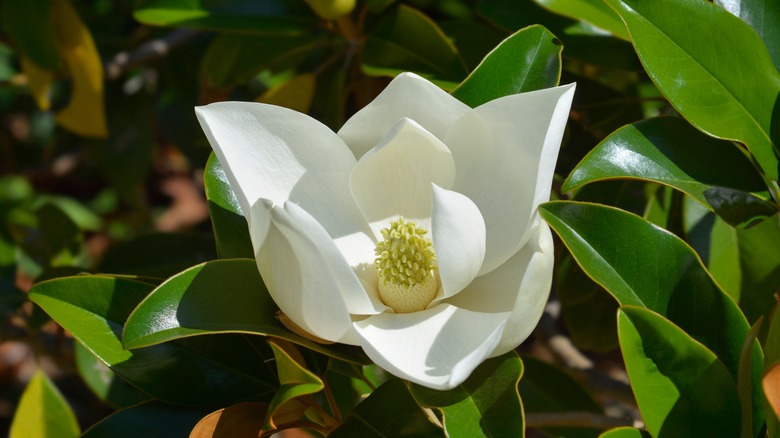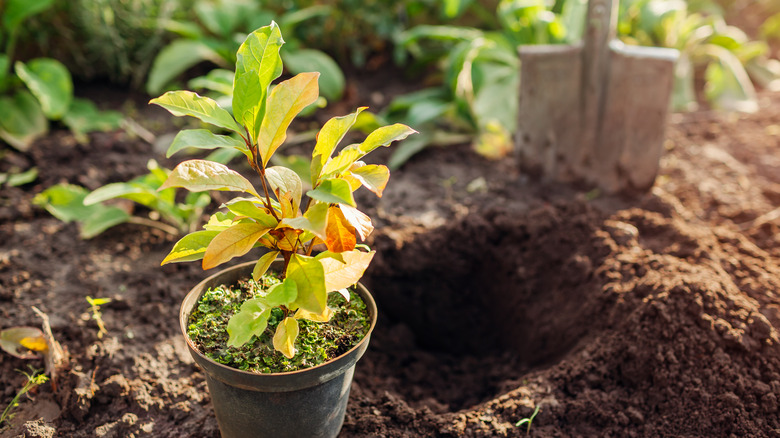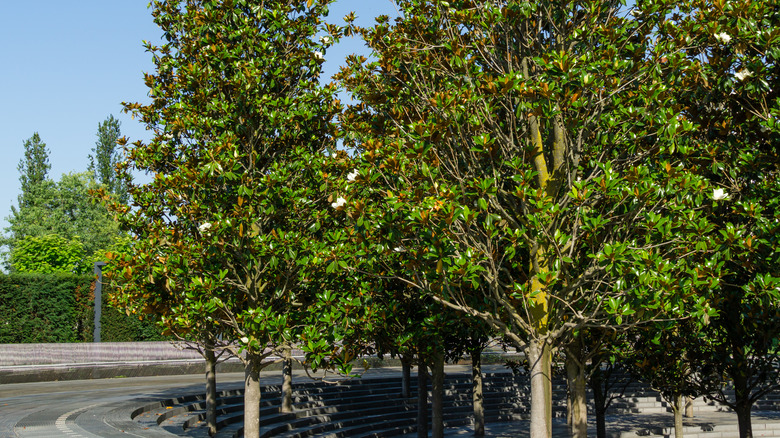The Gorgeous Magnolia Tree Variety That's Easy To Take Care Of
Magnolia trees are undeniably beautiful, deliciously fragrant, and enchanting in any garden. But with over 210 different types of magnolias to choose from, which one is "The One"? The Magnolia grandiflora, also known as "Little Gem," is a compact variety of the southern magnolia and a standout choice for gardeners seeking the splendor of magnolias without the usual space and care demands.
The "Little Gem" is a dwarf version of the majestic Magnolia grandiflora, known for its glossy, dark green leaves and large, fragrant white flowers. What sets "Little Gem" apart is its manageable size, growing to about 20 to 25 feet tall and 10 to 15 feet wide in maturity, significantly smaller than its parent species, which can reach up to 80 feet. It has a low canopy clearance of about three feet from the ground. This makes it ideal for smaller gardens or as a feature in larger landscapes.
This magnolia variety has a narrow, upright growth habit, and its evergreen leaves, with a rusty brown underside, remain lustrous throughout the year. The tree's true glory, however, lies in its flowers. They bloom from a young age (about two to three years after planting), producing creamy white, cup-shaped flowers that can be up to eight inches in diameter. These blooms emit a subtle, sweet fragrance, which, if you know what magnolia smells like, is simply irresistible. The flowering season typically begins in the spring and lasts through the summer.
How to take care of your Little Gem
"Little Gem" thrives in United States Department of Agriculture's Hardiness Zones 7 to 9, preferring full sun (six or more hours daily) with some tolerance for shade. Planting your magnolia tree in the spring and fall would be the best. Although this tree is considered compact above ground, the roots below are anything but. The root system can extend at a distance roughly four times the width of the canopy, so avoid planting it within approximately 15 feet of a concrete foundation.
It is adaptable to various soil types but prefers acidic, nutrient-rich, well-drained soil. Young "Little Gem" trees require regular generous watering to establish a deep, extensive root system — around three times a week is suggested. Once established, watering can be reduced to once or twice a week. They are relatively drought-tolerant, but consistent moisture is beneficial, especially during dry spells. This magnolia does have a slow growth rate. However, if you take good care of it, "Little Gem" can live over 80 years.
Fertilizing the magnolia tree in the springtime with a balanced, slow-release fertilizer encourages healthy growth and flowering. Mulching is a good idea as well, especially for newly planted trees and during the wintertime. Around two inches of mulch will protect the roots, maintain moisture, and keep weeds away. This magnolia has very minimal pruning requirements, generally limited to removing dead or crossing branches, and should only be done after flowering. Avoid heavy pruning, as this can reduce flowering, and maintain branches at ground level to keep the tree's natural pyramid-like shape.
Resistance and versatility perks of this magnolia tree
One of the most appealing qualities of the "Little Gem" is its resistance to many pests and diseases that commonly affect magnolias. Plant scale bugs can be an occasional pest, but neem oil, rubbing alcohol, and other solutions can help get rid of the scales. Also, if deer tend to pay visits to your garden, they will likely leave deer-resistant "Little Gem" alone in search of tastier plants to eat. It is also quite hardy against salt. However, this magnolia doesn't particularly like inner-city pollution. Planting in a sheltered location is recommended to protect the tree from strong winds, which can damage the large leaves and flowers.
Versatility makes this magnolia a favorite among landscape designers. It can be used as an accent tree, in group plantings for screening, or even in large containers for patios and terraces. Its compact size and elegant appearance make it a focal point in any setting. Beyond its aesthetic appeal, as a native species, "Little Gem" provides environmental benefits by supporting local ecosystems. Birds are attracted to the tree's foliage for shelter and nesting, while the flowers can attract pollinators like bees and butterflies. Whether you are an experienced gardener or a beginner, the "Little Gem" is a gorgeous, low-maintenance, and totally delightful addition that promises to bring beauty and tranquility to your garden space.


